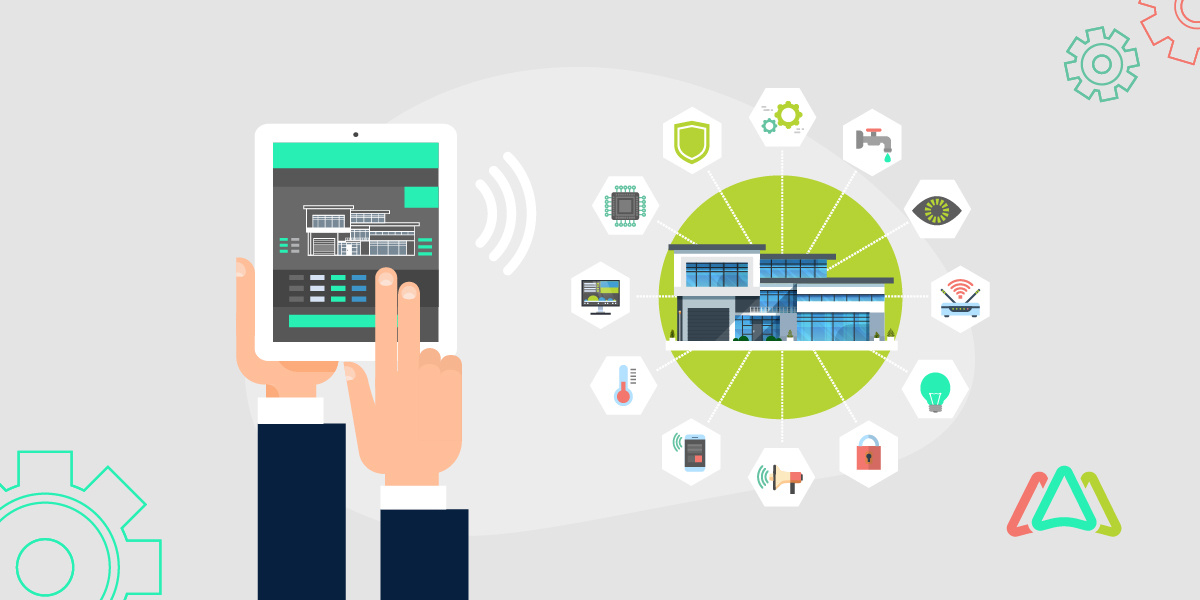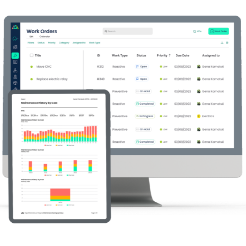
Real-World Applications of CMMS and IoT in Various Industries
Picture this: a bustling factory floor where machines hum efficiently, a luxury hotel where every room offers perfect comfort, and a power plant ensuring uninterrupted energy supply. In each of these settings, IoT sensors are quietly at work, monitoring equipment and sending real-time alerts to the CMMS (Computerized Maintenance Management System). When an issue arises—whether it’s a temperature spike in the HVAC system or a malfunction in an elevator, IoT sensors detect the problem and send an immediate notification. The maintenance team or professional then takes swift action, preventing costly disruptions.
These are a few examples of real-world applications of CMMS and IoT integration—an effective solution that is transforming maintenance strategies across diverse industries. CMMS acts as the brain, automating maintenance tasks and tracking asset health, while IoT sensors provide real-time data to predict and prevent issues. Together, they enable businesses to move from reactive fixes to proactive, data-driven maintenance.
Industries like manufacturing, hospitality, and retail are already reaping the benefits. Manufacturers keep machines running efficiently, hotels ensure seamless guest experiences, and retailers prevent inventory spoilage and equipment failures.
In this article, we explore real-world CMMS IoT use cases and uncover how these technologies are revolutionizing maintenance operations across industries.
Understanding CMMS and IoT
To understand what’s behind modern maintenance strategies, let’s break down two key players: CMMS and IoT.
What is a CMMS?
A CMMS (Computerized Maintenance Management System) is a digital hub for streamlining maintenance operations, ensuring equipment reliability, and minimizing downtime. It automates critical processes like scheduling preventive maintenance, tracking work orders and repair history, managing spare parts inventory, and analyzing maintenance performance through detailed reports. These functionalities help reduce equipment failures, optimize resource allocation, and boost productivity in maintenance departments. From manufacturing plants to hotels, a CMMS empowers maintenance teams to stay organized and efficient, keeping operations running smoothly and avoiding costly disruptions.
What is IoT (Internet of Things)?
The Internet of Things (IoT) refers to the network of physical devices connected to the Internet, enabling them to collect, share, and exchange data in real time. In the context of maintenance, IoT sensors play a pivotal role by continuously monitoring equipment health around the clock, providing valuable insights into asset performance. For example, temperature sensors can detect overheating in machinery, preventing potential breakdowns. Vibration sensors help identify early signs of wear in rotating equipment, allowing for timely maintenance before a failure occurs. Humidity sensors protect sensitive electrical systems from moisture damage, which can lead to costly repairs. Energy meters track energy usage, helping businesses identify inefficiencies and optimize energy consumption. With these sensors in place, companies can gain a deeper understanding of their assets’ condition and make informed decisions, preventing unexpected failures and minimizing downtime.
The Synergy of CMMS and IoT
When CMMS and IoT work together, they create a powerful system for predictive and preventive maintenance. IoT sensors continuously gather data and send alerts about potential issues while the CMMS schedules the necessary maintenance tasks and logs the repairs.
For example, if a vibration sensor detects unusual activity in a machine, it can trigger the CMMS software to generate a work order or maintenance task for inspection automatically. This proactive approach reduces downtime, extends asset life, and cuts maintenance costs.
Together, CMMS and IoT redefine maintenance by making it smarter, faster, and more efficient.
Real-World Applications of CMMS and IoT
Manufacturing Industry: Enhancing Production Efficiency
In manufacturing, downtime can be costly. IoT sensors monitor equipment performance, tracking metrics like vibration and temperature to detect early issues. When problems arise, the CMMS schedules preventive maintenance automatically, preventing breakdowns.
For example, in the automotive industry, sensors track assembly line equipment health, while the CMMS ensures timely repairs, keeping production on track. The benefits? Reduced downtime, longer asset life, and greater operational efficiency—allowing manufacturers to maintain smooth and efficient operations.
Hospitality Industry: Improving Guest Experience and Operational Efficiency
In the hospitality industry, IoT powers smart systems like HVAC, lighting controls, and energy monitoring to maintain optimal conditions in real time. Paired with a CMMS, hotels efficiently manage maintenance schedules for facilities, pools, elevators, and guest rooms. For example, a luxury hotel chain leverages IoT and CMMS to detect and address issues before guests notice, ensuring 24/7 comfort. This integration results in energy efficiency, cost savings, and significantly enhanced guest satisfaction, creating a seamless experience for visitors.
Retail Industry: Optimizing Store Operations
In retail, IoT powers smart refrigeration, temperature monitoring, and automated lighting systems to maintain optimal store conditions. Combined with a CMMS, retailers ensure critical equipment like POS systems, HVAC units, and refrigerators stay operational. For example, supermarkets use IoT to monitor refrigeration and CMMS to schedule maintenance, preventing spoilage and ensuring smooth operations. This synergy delivers cost savings, fewer equipment failures, and a consistent customer experience, keeping stores running efficiently.
Healthcare Industry: Ensuring Patient Safety and Compliance
In healthcare, IoT sensors are used to monitor critical medical equipment like MRI machines and ventilators, as well as hospital infrastructure, ensuring they operate optimally. Paired with a CMMS, hospitals automate maintenance tasks, track compliance requirements, and prevent equipment downtime. For instance, many hospitals integrate IoT and CMMS to maintain regulatory compliance and ensure equipment is always available for patient care. This combination enhances patient safety, ensures regulatory compliance, and improves operational reliability, making healthcare facilities more efficient and dependable.
Energy Sector: Maintaining Power Plants and Renewable Energy Systems
In the energy sector, IoT enables real-time monitoring of turbines, solar panels, and grid systems to ensure optimal performance. At the same time, CMMS streamlines preventive maintenance and inventory management for critical assets. For example, wind farms use IoT sensors to track turbine health and performance, with CMMS automating maintenance schedules to maximize uptime and energy output. This combination results in lower maintenance costs, reduced downtime, and improved energy efficiency, ensuring reliable and sustainable energy production.
Transportation and Logistics: Keeping Fleet and Infrastructure Operational
In transportation and logistics, IoT plays a key role by enabling vehicle tracking, fuel usage monitoring, and predictive diagnostics to ensure fleet efficiency. When integrated with CMMS, it helps schedule fleet maintenance, track repair history, and automate work orders. For instance, logistics companies use IoT and CMMS to monitor vehicle health, optimize maintenance schedules, and improve fleet performance, leading to on-time deliveries. This integration results in lower operational costs, improved fleet reliability, and enhanced customer satisfaction.
Benefits of CMMS and IoT Integration Across Industries
Integrating CMMS and IoT offers numerous advantages. It improves equipment reliability through real-time monitoring and predictive maintenance. It enhances resource allocation by automating schedules and optimizing asset management. Real-time data insights enable smarter, proactive decision-making. This CMMS IoT integration reduces downtime, lowers costs, and boosts overall operational performance, offering businesses a powerful edge.
Challenges and Risks of Integrating CMMS and IoT
While CMMS and IoT integration offers transformative benefits, it’s not without its challenges. Businesses may face hurdles such as significant upfront costs, complex integrations with legacy systems, and concerns over data security. Without proper analytics, the overwhelming volume of IoT data can also hinder rather than help decision-making. To navigate these obstacles effectively, careful planning and expert guidance are essential. For a more in-depth look at these challenges and practical steps to overcome them, explore our recent blog post on Overcoming CMMS and IoT Integration Challenges. It sheds light on how to address these barriers and pave the way for seamless implementation.
Future Trends in CMMS and IoT for Industry Applications
The future of CMMS and IoT in industry applications lies in integrating AI and machine learning for enhanced predictive analytics, which will enable even more accurate maintenance forecasting. Advanced IoT devices with edge computing capabilities will allow for faster data processing and real-time decision-making. As industries like agriculture and smart cities increasingly adopt these technologies, we will see wider implementation across emerging sectors. Additionally, the growth of cloud-based CMMS platforms with IoT compatibility will provide more flexible, scalable, and cost-effective solutions for businesses looking to stay ahead in maintenance management.
Conclusion
The integration of CMMS and IoT has proven transformative across diverse industries, driving improved maintenance efficiency, reducing downtime, and enhancing operational performance. By applying these technologies, businesses can gain a competitive edge by optimizing resources, promoting proactive maintenance strategies, and promoting smarter, data-driven decision-making to adapt to evolving industry demands effectively.
TABLE OF CONTENTS
Keep Reading
Every maintenance professional faces it sooner or later — that critical time when an aging ...
18 Nov 2025
The term 'best' is often used loosely, without a clear understanding of its context or ...
14 Nov 2025
In the not too distant past, maintenance strategies have been defined by reaction—fixing ...
13 Nov 2025
Tax season is the time of year that often sends a ripple of anxiety through many of us. The ...
11 Nov 2025
Selecting a Computerized Maintenance Management System (CMMS) can, at first glance, be an ...
4 Nov 2025
In healthcare facilities, equipment uptime involves more than achieving operational ...
31 Oct 2025
Companies are subject to economic ups and downs, also known as economic volatility. Today, ...
30 Oct 2025
Maintenance challenges are a constant struggle, with unplanned downtime costing manufacturers ...
27 Oct 2025
Last winter, a maintenance technician at a U.S. paper mill ignored a predictive alert that ...
10 Oct 2025
Many organizations proudly say they “have a CMMS,” but ownership alone doesn’t equal ...
9 Oct 2025
Every maintenance team is under pressure to do more with less. Unplanned downtime is often ...
7 Oct 2025
The implementation of simple, yet powerfully effective, checklists has repeatedly ...
3 Oct 2025
In manufacturing, every second counts. When production stops, whether due to scheduled ...
2 Oct 2025
The increasing cost of maintenance, lack of accountability, and siloed systems leave many ...
30 Sep 2025
Preventive maintenance is one of those things maintenance teams know they need to do, but it ...
26 Sep 2025
Public services are essential to daily life. The provision of safe roads, functional transit, ...
25 Sep 2025
For most manufacturing facilities, a major focus of their maintenance teams revolves around ...
24 Sep 2025
Have you ever tried explaining to the CEO why the production line has been down for hours ...
18 Sep 2025
Over the past few decades, the hotel industry has undergone a dramatic transformation. ...
16 Sep 2025
Profitability is at the top of the list for manufacturing organizations when conversations ...
12 Sep 2025







